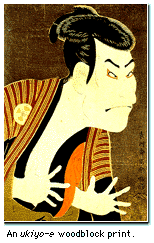 |
What are ukiyo-e? |
 |
Ukiyo-e are paintings for commoners that appeared in the first half of the Edo period (1603-1868) and continued to be drawn for about two and a half centuries. For the most part, ukiyo-e were colored woodblock prints, although brush paintings were also produced.
Among the most famous ukiyo-e works are the "53 Stations of the Tokaido Road" series by Ando Hiroshige; the "36 Views of Mt. Fuji" series by Katsushika Hokusai, in which the painter draws Japan's tallest peak from various angles; "Beauty Playing the Glass Pipe," Kitagawa Utamaro's well-known portrait of a beautiful woman; and Toshusai Sharaku's ukiyo-e of kabuki actors. In the late nineteenth and early twentieth centuries ukiyo-e that found their way to Europe and the United States were praised for their artistic merit and triggered a boom of interest in Japan. Their composition and techniques exerted an enormous influence on such schools as Impressionism and Art Nouveau. Photo courtesy of Tokyo National Museum. |
 | |
 Common themes of ukiyo-e paintings were actors, beautiful women, and landscapes. Another popular subject was the latest forms of entertainment among people in Edo (now Tokyo); the paintings thus became a valuable source of information about lifestyle and social trends.
Common themes of ukiyo-e paintings were actors, beautiful women, and landscapes. Another popular subject was the latest forms of entertainment among people in Edo (now Tokyo); the paintings thus became a valuable source of information about lifestyle and social trends.